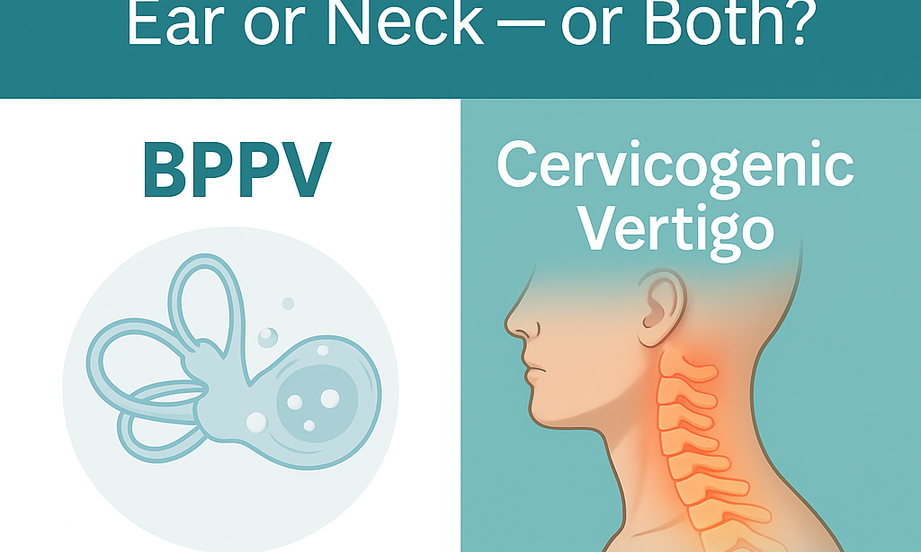Understanding Vertigo: The Difference Between BPPV and Cervicogenic Vertigo
Feeling dizzy, off-balance, or like the room is spinning can be unsettling. Vertigo is a common complaint that can have different causes — and two of the most frequent are Benign Paroxysmal Positional Vertigo (BPPV) and Cervicogenic Vertigo. Although they can feel similar, their sources — and treatments — are very different. Sometimes, they can even occur together, creating more complex and persistent dizziness.
What Is Vertigo?
Vertigo isn’t a diagnosis — it’s a symptom. It describes the false sensation of movement or spinning, often triggered by changes in position, head movement, or even stress. Vertigo can interfere with balance, concentration, and daily activities like driving, working, or even getting out of bed.
BPPV: When the Inner Ear Sends the Wrong Signals
Benign Paroxysmal Positional Vertigo (BPPV) is the most common cause of vertigo. It occurs when tiny calcium crystals (otoconia) inside the inner ear become dislodged and move into one of the semicircular canals, which are responsible for sensing rotation and movement.
Common signs of BPPV include:
- Sudden spinning sensations when rolling over in bed, bending down, or looking up
- Brief episodes lasting less than a minute
- Nausea or lightheadedness after certain head movements
- A feeling of imbalance that improves when you stay still
Treatment: BPPV is often successfully treated with repositioning maneuvers, such as the Epley maneuver, which guide the loose crystals back into their proper place. These can be performed safely in a clinical setting by a trained provider.
Cervicogenic Vertigo: When the Neck Is the Culprit
Cervicogenic vertigo originates from dysfunction or irritation in the neck (cervical spine) — particularly the muscles, joints, and nerves that send information about head position to the brain.
When these structures become stiff, inflamed, or imbalanced — often due to poor posture, whiplash, or cervical disc issues — the brain receives conflicting messages from the neck and inner ear. This sensory mismatch can cause dizziness, unsteadiness, or a sense of disorientation.
Typical features of cervicogenic vertigo include:
- Dizziness or lightheadedness triggered by neck movement or sustained postures
- Neck pain, stiffness, or headaches accompanying dizziness
- Imbalance that may persist longer than BPPV episodes
- Relief after improving neck mobility or posture
Treatment: Cervicogenic vertigo is best addressed by correcting the underlying neck dysfunction. This may involve:
- Gentle cervical mobilization or spinal rehabilitation
- Postural retraining and ergonomic education
- Targeted exercises to strengthen deep neck stabilizers and improve proprioception
- Relaxation or breathing strategies for tension-related symptoms
When BPPV and Cervicogenic Vertigo Happen Together
In some cases, both BPPV and cervicogenic vertigo are present at the same time. This is especially common after:
- A whiplash injury, where both the neck and inner ear are affected
- A fall or concussion, which can dislodge ear crystals and strain the cervical spine
- Long-term neck tension or poor posture, which disrupts both balance input and neck proprioception
When both conditions overlap, patients often describe:
- Persistent dizziness that fluctuates with both head and neck movements
- A combination of spinning sensations (from BPPV) and imbalance, lightheadedness or a general feeling of unsteadiness (from neck dysfunction)
- Slower recovery when only one cause is treated
Comprehensive treatment is key in these situations. Addressing only the inner ear crystals or only the neck dysfunction can leave symptoms lingering. The most effective approach includes:
- Repositioning maneuvers for BPPV
- Cervical spine mobilization, posture correction, and strengthening
- Vestibular rehabilitation to retrain balance and coordination between the neck, eyes, and inner ear
This integrated approach helps recalibrate the body’s balance system, often leading to faster and more lasting relief.
Key Differences and Overlaps

When to See a Professional
Because vertigo can stem from multiple sources — including both the inner ear and cervical spine — it’s important to get a comprehensive assessment. At The Center for Total Back Care in Mesa, we specialize in identifying the root cause of dizziness and imbalance. Whether your vertigo comes from the inner ear, the neck, or both, our integrated approach to vestibular and spinal rehabilitation helps restore balance, reduce symptoms, and improve quality of life.
Ready to Get Your Balance Back?
Don’t let dizziness control your day. The right diagnosis makes all the difference and our team is here to help you find lasting relief.
Schedule online at www.totalback.com or call The Center for Total Back Care 480 633-8293We proudly serve patients across Mesa, Chandler, Gilbert, and Tempe, Arizona.
